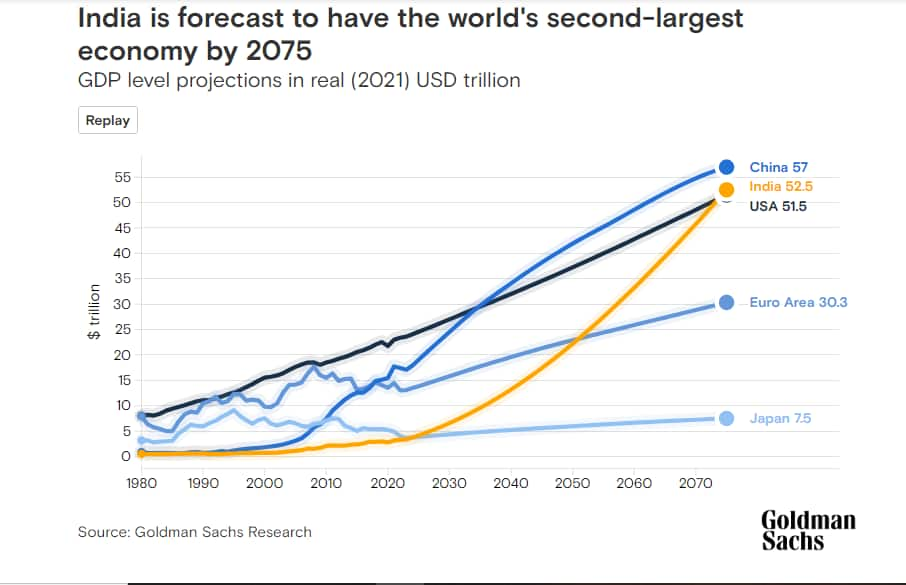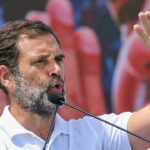By Anjan Roy
Goldman Sachs is at its old game again — that is, exceedingly long term projections of the comparative growth of economies and trying to foresee the shape of the global economy over, say, fifty years.
The global investment bank’s latest projections show India in an exceedingly happy colour. It will be the second largest economy in the world in 2075 and the size of its GDP should be as big as $52.5 trillion. The first would be that of China at $57 trillion. The present day Goliath, United States, should have a GDP of $51.7 trillion.
The first time Goldman got into this business of projections, it had identified four countries which should become giants of the future. These were Brazil, Russia, India and China. Later on, South Africa had joined the august band, thus BRIC has become BRICS.
That was over a decade back and now it is possibly taking a second look. But going by the present status of the vaunted five, only India and China seem to have borne out the Goldman optimism. India and China are on their way to greatness. The others appear to have somewhat fizzled out. The most spectacular disappointment has been Russia. Despite it having everything on its side to sprint along the growth path, the country had put itself into a vortex of a downward spiral.
Pursuing its vanity of an imperial dream and coveting small little parcels of land when it has almost half the globe in its territory already, Russia has pursued a foolish path towards destruction. Against such reality of a decrepit present, it had everything going for it: its manpower had world beating potentials in innovations and scientific achievements, its resources were immense and far more than any other major economy. Yet, its political leadership had landed it in catastrophe.
Next in line is China. Its achievements over the last three and a half decades have been stellar by any yardstick. Never before a country had pulled up its vast poor above destitution as China did with breakneck speed of growth and development.
It built up its economy from the ashes of another ill-conceived political campaign — Mao Tse Tung’s Cultural Revolution — when the country had suffered one of humanity’s worst mass starvation and death. With its liberal policies after the strangulating regimes of earlier years, Deng Tsiao Ping, had changed the country beyond recognition during his tenure.
Now nearly forty years after its opening up, China is already the second largest economy in the world. Varying estimates put it that close to 800 million people have been lifted out of abject poverty and the rich Chinese are the largest conspicuous consumers in the world. No large global company can ignore the Chinese market for the incomparably large size of demand.
Along with radical economic reforms, Deng had introduced even more radical political and institutional reforms. Most important, Deng had sought to ensure an institutional mode of rule, against authoritarian control, which is subject to the whims and fancies of an autocrat. Deng had introduced collective rule at the top, thus seeking to rule out individual idiosyncrasies of an autocrat. Thus, a collective decision-making could avoid the errors of a single autocrat.
With this system, Deng had introduced a strict rule of time bound offices at the highest level. Thus, the Chinese president was to have only two terms of five years each, as in say other mature large countries, like United States or in Europe.
The current Chinese leader and president, Xi Jinping, had scrapped both these rules and ordained himself with life long tenure at the top. Xi has surrounded himself with sycophants and yes-men thus no one dares to point out any mistakes in judgment.
These are curious parallels — Russia and China. Both the supreme leaders of the two countries have pursued a strikingly similar paths. Both have captured power which they have sought, by hook or crook, for lifelong tenures. Both have undermined all institutional structure to ensure severely autocratic rules. Above all, both are imbued with past history of national glory and imperial dreams. The Russian autocrat is dreaming of Peter the Great and sprawling empires in East Europe.
The Chinese autocrat is referring to Chinese Imperial glory and always referring to the Chinese rules in expanding concentric circles. According to Xi’s views, the current boundaries of China is the first concentric circle of the Chinese historical empires. Then comes the somewhat larger concentric circle, which includes tributary nations, such as, Japan, Korea, entire south-east Asia. Thus, the whole extent of South China Sea, which has served as International seaway for the world, is being claimed as Chinese sovereign territory.
Xi’s ambitions do not stop there. For him, China extends into south Asia and large parts of Indian territory belongs to China. XI is already competing with Russia, claiming subservience of Central Asia countries, from Kazakhstan, Turkmenistan, and other former Soviet republics.
In no time, the two “best friends” —Russia and China, as announced by them prior to former Ukraine invasion— are likely to cross swords. Russia had occupied north east Asian territories adjoining Chinese borders as large as the size of Ukraine. Vladivostok is claimed by China as its own town.
China is on a global crash course. It is picking up territorial fights with all its neighbours — some fourteen of them. It has the world’s largest boundary with neighbouring countries — some 24,000 kilometres long and large claims in the world’s seas. China is pursuing to see its imprint across the world and coming close to fighting battles.
In 2075, the terminal year of Goldman Sachs’ prediction cycle, India would surely be first or second largest and United States might still be vying for the pride of place with India. Going by this year’s economic performance, Indian economy is regaining the poise it had before the pandemic struck. We are almost where we would have reached had the pandemic not played devastation. Hopefully, at least on one count the Gold Sachs prediction will not go astray. India will be at the top. (IPA Service)

 Rahul Gandhi Set To Upset Narendra Modi In Five States
Rahul Gandhi Set To Upset Narendra Modi In Five States 